Paper Menu >>
Journal Menu >>
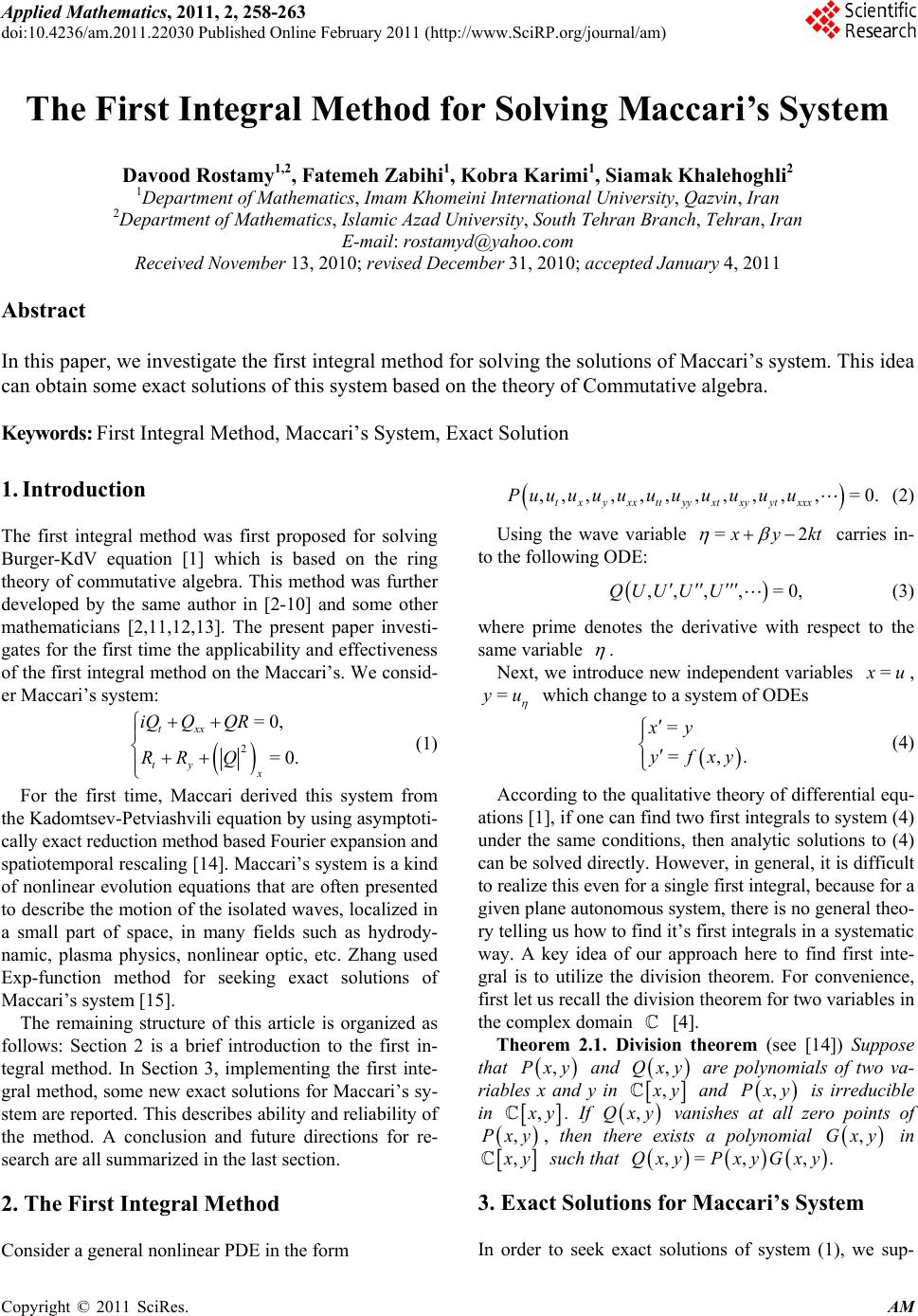 Applied Mathematics, 2011, 2, 258-263 doi:10.4236/am.2011.22030 Published Online February 2011 (http://www.SciRP.org/journal/am) Copyright © 2011 SciRes. AM The First Integral Method for Solving Maccari’s System Davood Rostamy1,2, Fatemeh Zabihi1, Kobra Karimi1, Siamak Khalehoghli2 1Department of Mat hem at ic s, Imam Khomeini International University, Qazvin, Iran 2Department of Mat hem at ic s, Islamic Azad University, South Tehran Branch, Tehran, Iran E-mail: rostamyd@yahoo.com Received November 13, 2010; revised December 31, 2010; accepted January 4, 2011 Abstract In this paper, we investigate the first integral method for solving the solutions of Maccari’s system. This idea can obtain some exact solutions of this system based on the theory of Commutative algebra. Keywords: First Integral Method, Maccari’s System, Exact Solution 1. Introduction The first integral method was first proposed for solving Burger-KdV equation [1] which is based on the ring theory of commutative algebra. This method was further developed by the same author in [2-10] and some other mathematicians [2,11,12,13]. The present paper investi- gates for the first time the applicability and effectiveness of the first integral method on the Maccari’s. We consid- er Maccari’s system: 2 =0, =0. txx ty x iQ QQR RR Q (1) For the first time, Maccari derived this system from the Kadomtsev-Petviash vili equ ation by using asymptoti- cally exact reduction me t hod based Fo uri er expansi o n an d spatiotemporal rescaling [14]. Maccari’s system is a kind of nonlinear evolution equations that are often presented to describe the motion of the isolated waves, localized in a small part of space, in many fields such as hydrody- namic, plasma physics, nonlinear optic, etc. Zhang used Exp-function method for seeking exact solutions of Maccari’s system [15]. The remaining structure of this article is organized as follows: Section 2 is a brief introduction to the first in- tegral method. In Section 3, implementing the first inte- gral method, some new exact solutions for Maccari’s sy- stem are reported. This describes ability and reliability of the method. A conclusion and future directions for re- search are all summarized in the last section. 2. The First Integral Method Consider a general nonlinear PDE in the form ,,,,,,, ,,,,=0. txyxxttyyxtxyytxxx Puuu uuuuuuuu (2) Using the wave variable =2 x ykt carries in- to the following ODE: ,, ,,=0,QUU UU (3) where prime denotes the derivative with respect to the same variable . Next, we introduce new independent variables = x u, =yu which change to a system of ODEs = =,. xy yfxy (4) According to the qualitative theory of differential equ- ations [1], if one can find two first integrals to system (4) under the same conditions, then analytic solutions to (4) can be solved directly. However, in general, it is difficult to realize this even for a single first integral, because for a given plane autonomous system, there is no general theo- ry telling us how to find it’s first integrals in a systematic way. A key idea of our approach here to find first inte- gral is to utilize the division theorem. For convenience, first let us recall the division theorem for two variables in the complex domain [4]. Theorem 2.1. Division theorem (see [14]) Suppose that ,Pxy and ,Qxy are polynomials of two va- riables x and y in , x y and ,Pxy is irreducible in , x y. If ,Qxy vanishes at all zero points of ,Pxy, then there exists a polynomial ,Gxy in , x y such that ,= ,,.QxyPxyGxy 3. Exact Solutions for Maccari’ s System In order to seek exact solutions of system (1), we sup- 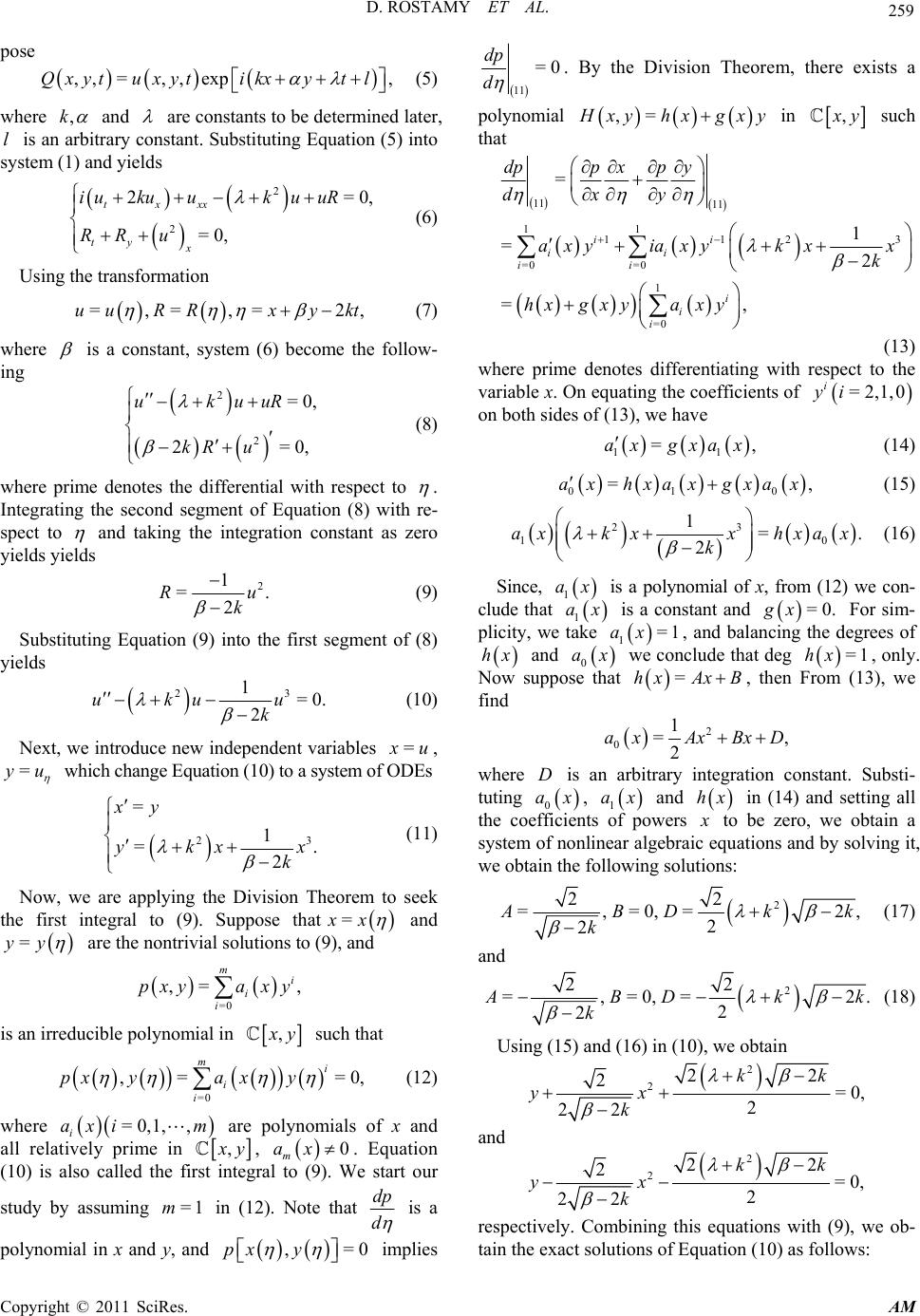 D. ROSTAMY ET AL. Copyright © 2011 SciRes. AM 259 pose ,,=,, exp,Qxytuxytikxytl (5) where ,k and are constants to be determined later, l is an arbitrary constant. Substituting Equation (5) into system (1) and yields 2 2 2=0, =0, txxx ty x iukuuku uR RR u (6) Using the transformation =, =, =2,uuRRxykt (7) where is a constant, system (6) become the follow- ing 2 2 =0, 2=0, ukuuR kR u (8) where prime denotes the differential with respect to . Integrating the second segment of Equation (8) with re- spect to and taking the integration constant as zero yields yields 2 1 =. 2 Ru k (9) Substituting Equation (9) into the first segment of (8) yields 23 1=0. 2 uku u k (10) Next, we introduce new independent variables = x u, =yu which change Equation (10) to a system of ODEs 23 = 1 =. 2 xy ykx x k (11) Now, we are applying the Division Theorem to seek the first integral to (9). Suppose that =xx and =yy are the nontrivial solutions to (9), and =0 ,= , mi i i pxya xy is an irreducible polynomial in , x y such that =0 ,= =0, mi i i pxya xy (12) where =0,1, , i axi m are polynomials of x and all relatively prime in , x y, 0 m ax. Equation (10) is also called the first integral to (9). We start our study by assuming =1m in (12). Note that dp d is a polynomial in x and y, and ,=0px y implies 11 =0 dp d . By the Division Theorem, there exists a polynomial ,= H xyhxgxy in , x y such that 11 11 11 1123 =0 =0 1 =0 = 1 =2 =, ii ii ii i i i dpp xp y dxy axyiaxyk xx k hxgxya xy (13) where prime denotes differentiating with respect to the variable x. On equating the coefficients of =2,1,0 i yi on both sides of (13), we have 11 =,ax gxax (14) 010 =,axhxax gxax (15) 23 10 1=. 2 axk xxhxax k (16) Since, 1 ax is a polynomial of x, from (12) we con- clude that 1 ax is a constant and =0.gx For sim- plicity, we take 1=1ax , and balancing the degrees of hx and 0 ax we conclude that deg =1hx , only. Now suppose that =hxAxB, then From (13), we find 2 01 =, 2 axAx BxD where D is an arbitrary integration constant. Substi- tuting 0 ax , 1 ax and hx in (14) and setting all the coefficients of powers x to be zero, we obtain a system of nonlinear algebraic equations and by solving it, we obtain the following solutions: 2 22 =,=0,= 2, 2 2 A BDk k k (17) and 2 22 =,=0,=2. 2 2 A BDk k k (18) Using (15) and (16) in (10), we obtain 2 222 2=0, 2 22 kk yx k and 2 222 2=0, 2 22 kk yx k respectively. Combining this equations with (9), we ob- tain the exact solutions of Equation (10) as follows: 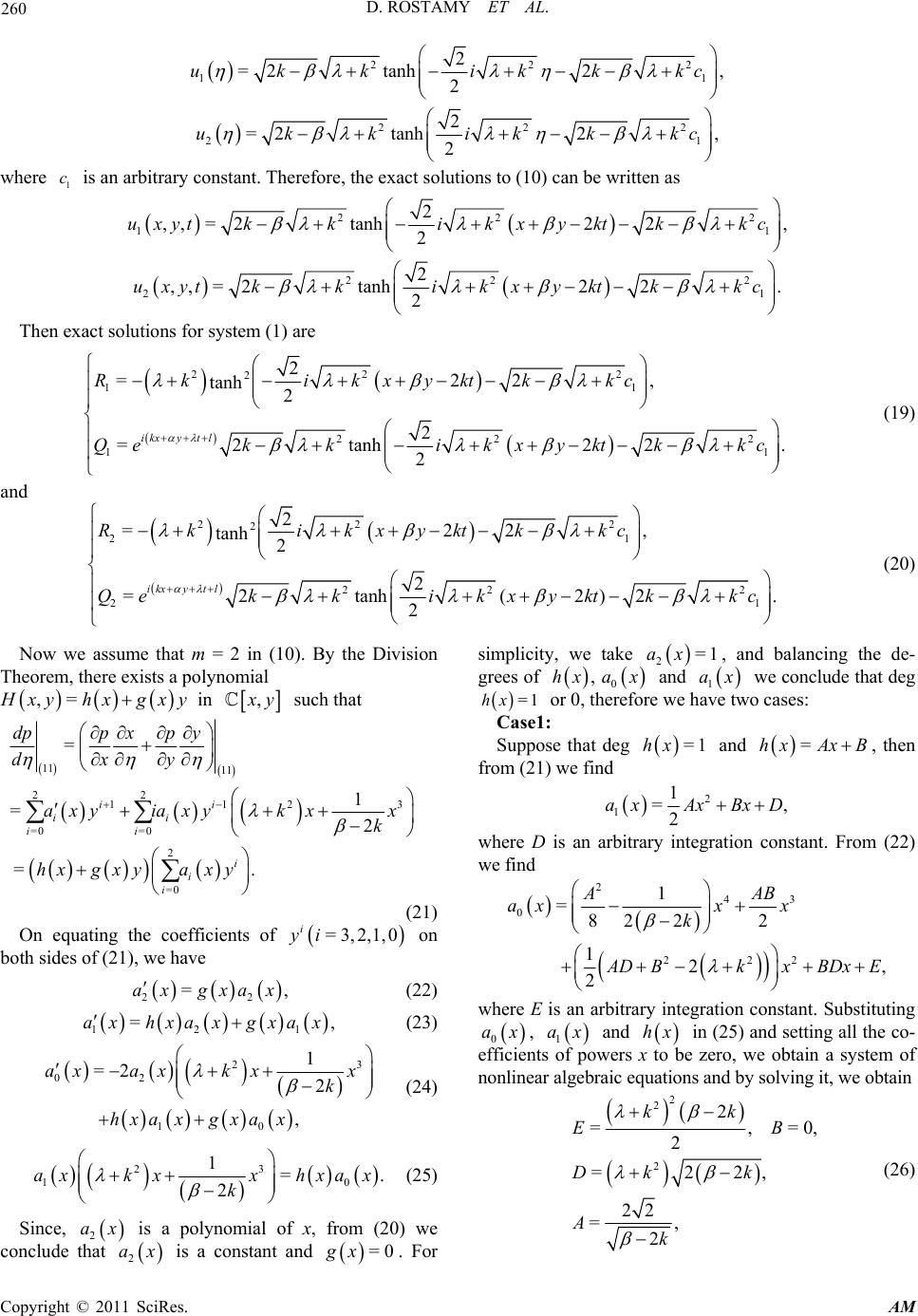 D. ROSTAMY ET AL. Copyright © 2011 SciRes. AM 260 222 1 1 2 =2tanh 2, 2 ukk ikkkc 22 2 2 1 2 =2tanh 2, 2 ukk ikkkc where 1 c is an arbitrary constant. Therefore, the exact solutions to (10) can be written as 22 2 1 1 2 ,,=2tanh 22, 2 uxytkkik xyktkkc 22 2 2 1 2 ,,=2tanh 22. 2 uxytkkikxyktkkc Then exact solutions for system (1) are 22 2 2 1 1 22 2 1 1 2 = 22, tanh 2 2 =2tanh 22. 2 ikxyt l Rk ikxyktkkc Qe kk ikxyktkkc (19) and 22 2 2 2 1 22 2 2 1 2 = 22, tanh 2 2 =2tanh (2)2. 2 ikxyt l Rk ikxyktkkc Qekkikx yktkkc (20) Now we assume that m = 2 in (10). By the Division Theor em, there exists a polynomial ,= H xyhx gxy in , x y such that 11 11 22 1123 =0 =0 2 =0 = 1 =2 =. ii ii ii i i i dpp xp y dxy axyiaxyk xx k hxgxyaxy (21) On equating the coefficients of =3,2,1,0 i yi on both sides of (21), we have 22 =,ax gxax (22) 121 =,axhxax gxax (23) 23 02 10 1 =2 2 , ax axkxx k hxaxgxax (24) 23 10 1=. 2 axk xxhxax k (25) Since, 2 ax is a polynomial of x, from (20) we conclude that 2 ax is a constant and =0gx . For simplicity, we take 2=1ax , and balancing the de- grees of ,hx 0 ax and 1 ax we conclude that deg =1hx or 0, therefore we have two cases: Case1: Suppose that deg =1hx and =hxAxB , then from (21) we f ind 2 11 =, 2 a xAxBxD where D is an arbitrary integration constant. From (22) we find 243 0 222 1 =82 22 12, 2 AAB axx x k A DBkx BDxE where E is an arbitrary integration constant. Substituting 0 ax, 1 ax and hx in (25) and setting all the co- efficients of powers x to be zero, we obtain a system of nonlinear algebraic equations and by solving it, we obtain 2 2 2 2 =,=0, 2 =22, 22 =, 2 kk EB Dkk Ak (26) 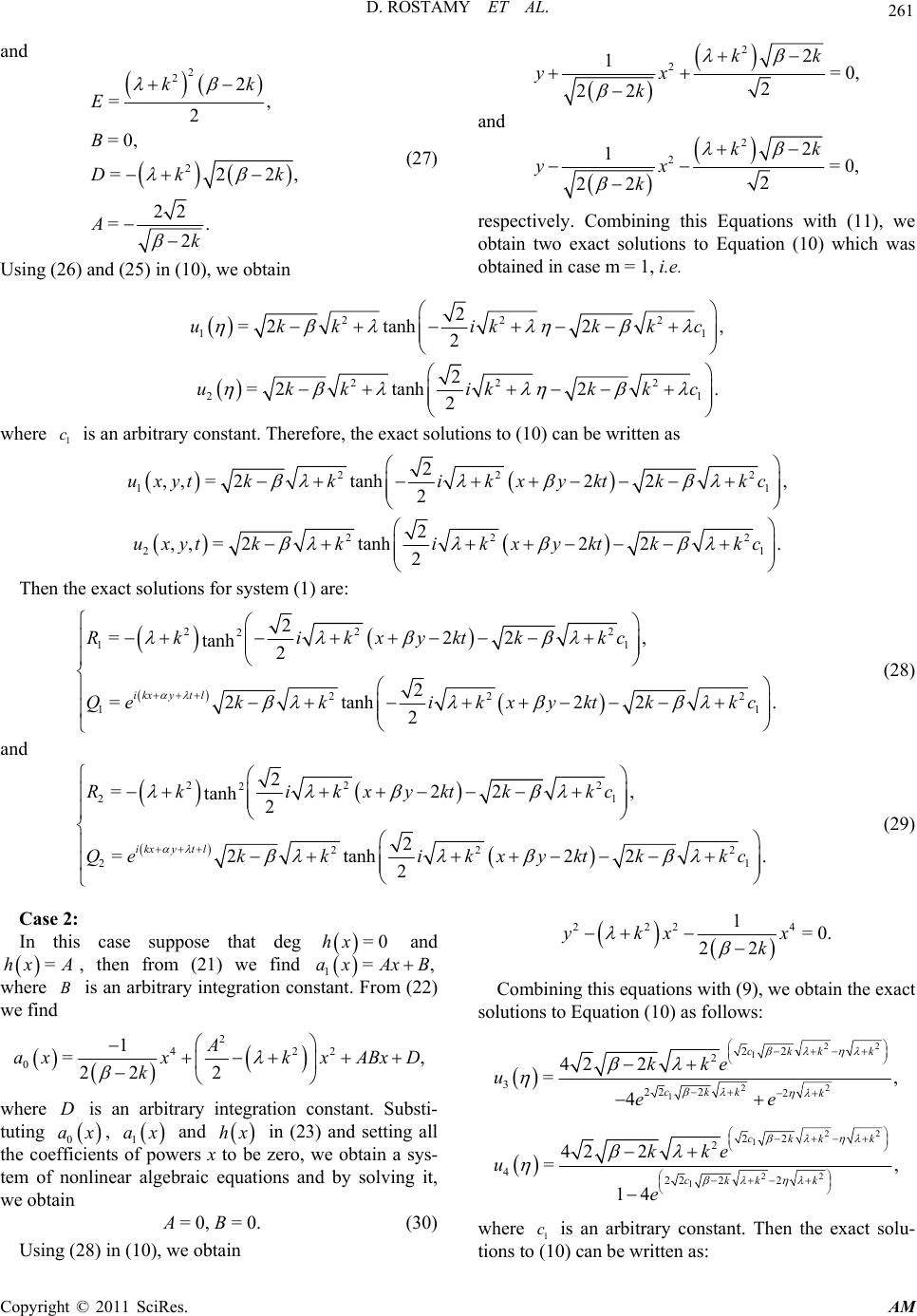 D. ROSTAMY ET AL. Copyright © 2011 SciRes. AM 261 and 2 2 2 2 =, 2 =0, =22, 22 =. 2 kk E B Dk k Ak (27) Using (26) and (25) in (10), we obtain 2 22 1=0, 2 22 kk yx k and 2 22 1=0, 2 22 kk yx k respectively. Combining this Equations with (11), we obtain two exact solutions to Equation (10) which was obtained in case m = 1, i.e. 222 1 1 2 =2tanh 2, 2 ukkik kkc 22 2 2 1 2 =2tanh 2. 2 ukkik kkc where 1 c is an arbitrary constant. Therefore, the exact solutions to (10) can be written as 22 2 1 1 2 ,,=2tanh 22, 2 uxytkkikxyktkkc 22 2 2 1 2 ,,=2tanh 22. 2 uxytkk ikxyktkkc Then the exact solutions for system (1) are: 22 2 2 1 1 22 2 1 1 2 = 22, tanh 2 2 =2tanh22 . 2 ikxyt l Rk ikxyktkkc Qe kk ikxyktkkc (28) and 22 2 2 2 1 22 2 2 1 2 =22, tanh2 2 =2tanh 22. 2 ikxytl Rk ikxyktkkc Qekkikx yktkkc (29) Case 2: In this case suppose that deg =0hx and =hxA , then from (21) we find 1=,ax AxB where B is an arbitrar y integration constant. From (22) we find 2 422 01 =, 22 2 A axxkxABxD k where D is an arbitrary integration constant. Substi- tuting 0 ax , 1 ax and hx in (23) and setting all the coefficients of powers x to be zero, we obtain a sys- tem of nonlinear algebraic equations and by solving it, we obtain =0, =0.AB (30) Using (28) in (10), we obtain 2224 1=0. 22 ykx x k Combining this equations with (9), we obtain the exact solutions to Equation (10) as follows: 22 1 22 1 22 2 32222 42 2 =, 4 ckk k ckk k kke uee 22 1 22 1 22 2 422 22 42 2 =, 14 ckk k ckk k kke u e where 1 c is an arbitrary constant. Then the exact solu- tions to (10) can be written as: 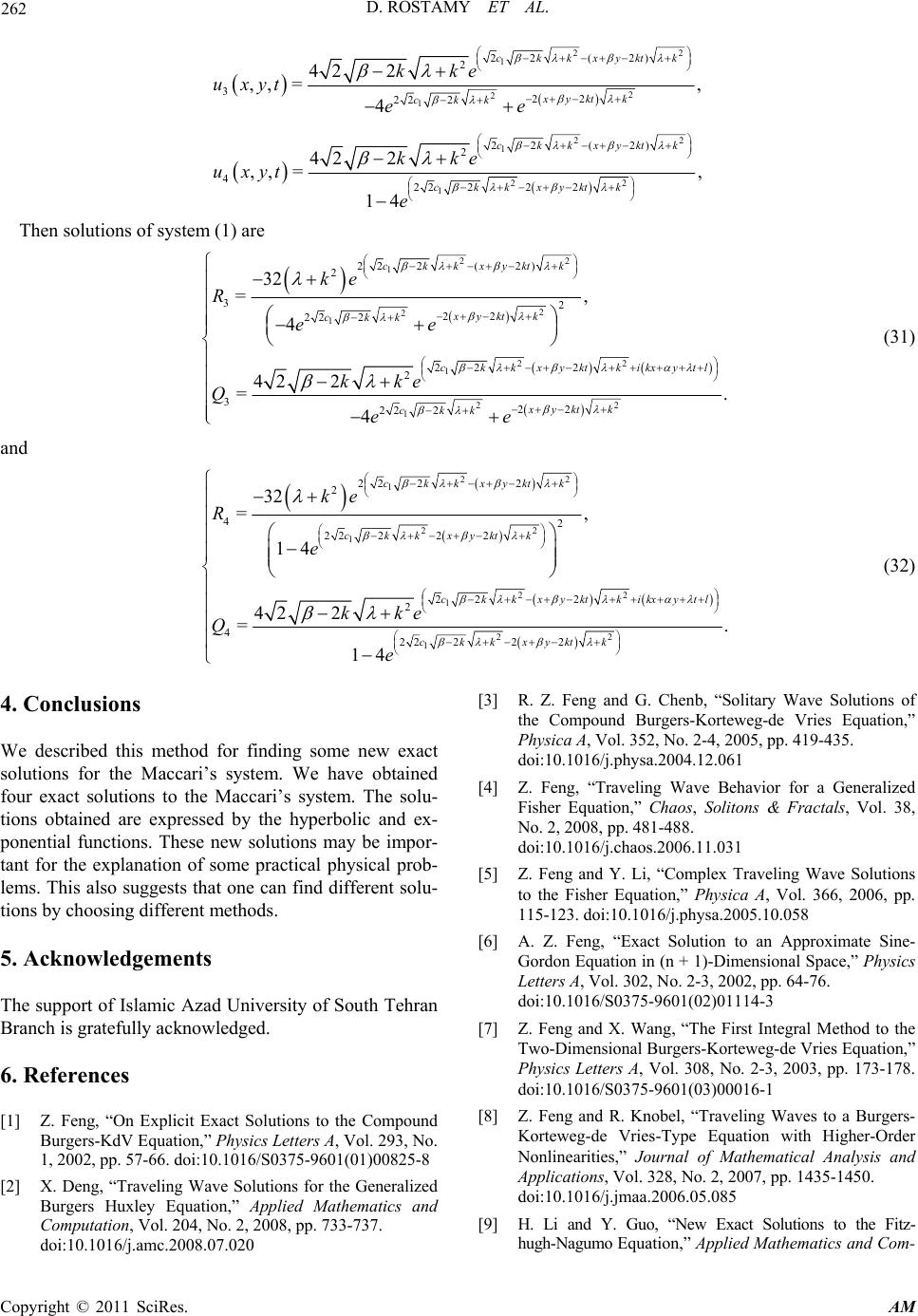 D. ROSTAMY ET AL. Copyright © 2011 SciRes. AM 262 22 1 2 2 1 22( 2) 2 322 22 2 42 2 ,, =, 4 ckkxyktk xykt k ckk kke uxyt ee 22 1 22 1 22( 2) 2 422 222 42 2 ,, =, 14 ckkxyktk ckkxyktk kke uxyt e Then solutions of system (1) are 22 1 2 2 1 22 1 2 2 1 22 2(2) 2 32 22 222 222 2 322 22 2 32 =, 4 42 2 =. 4 ckkxyktk xykt k ckk ckkxyktkikxytl xykt k ckk ke R ee kke Qee (31) and 22 1 22 1 22 1 22 1 22 22 2 42 22 222 222 2 422 222 32 =, 14 42 2 =. 14 ckkxyktk ckkxyktk ckkxyktkikxytl ckkxyktk ke R e kke Q e (32) 4. Conclusions We described this method for finding some new exact solutions for the Maccari’s system. We have obtained four exact solutions to the Maccari’s system. The solu- tions obtained are expressed by the hyperbolic and ex- ponential functions. These new solutions may be impor- tant for the explanation of some practical physical prob- lems. This also suggests that one can find different solu- tions by choosing different methods. 5. Acknowledgements The support of Islamic Azad University of South Tehran Branch is gratefully acknowledged. 6. References [1] Z. Feng, “On Explicit Exact Solutions to the Compound Burgers-KdV Equation,” Physics Letters A, Vol. 293, No. 1, 2002, pp. 57-66. doi:10.1016/S0375-9601(01)00825-8 [2] X. Deng, “Traveling Wave Solutions for the Generalized Burgers Huxley Equation,” Applied Mathematics and Computation, Vol. 204, No. 2, 2008, pp. 733-737. doi:10.1016/j.amc.2008.07.020 [3] R. Z. Feng and G. Chenb, “Solitary Wave Solutions of the Compound Burgers-Korteweg-de Vries Equation,” Physica A, Vol. 352, No. 2-4, 2005, pp. 419-435. doi:10.1016/j.physa.2004.12.061 [4] Z. Feng, “Traveling Wave Behavior for a Generalized Fisher Equation,” Chaos, Solitons & Fractals, Vol. 38, No. 2, 2008, pp. 481-488. doi:10.1016/j.chaos.2006.11.031 [5] Z. Feng and Y. Li, “Complex Traveling Wave Solutions to the Fisher Equation,” Physica A, Vol. 366, 2006, pp. 115-123. doi:10.1016/j.physa.2005.10.058 [6] A. Z. Feng, “Exact Solution to an Approximate Sine- Gordon Equation in (n + 1)-Dimensional Space,” Physics Letters A, Vol. 302, No. 2-3, 2002, pp. 64-76. doi:10.1016/S0375-9601(02)01114-3 [7] Z. Feng and X. Wang, “The First Integral Method to the Two-Dimensional Burgers-Korteweg-de Vries Equation,” Physics Letters A, Vol. 308, No. 2-3, 2003, pp. 173-178. doi:10.1016/S0375-9601(03)00016-1 [8] Z. Feng and R. Knobel, “Traveling Waves to a Burgers- Korteweg-de Vries-Type Equation with Higher-Order Nonlinearities,” Journal of Mathematical Analysis and Applications, Vol. 328, No. 2, 2007, pp. 1435-1450. doi:10.1016/j.jmaa.2006.05.085 [9] H. Li and Y. Guo, “New Exact Solutions to the Fitz- hugh-Nagumo Equ a t i on , ” Applied Mathematics and Com- 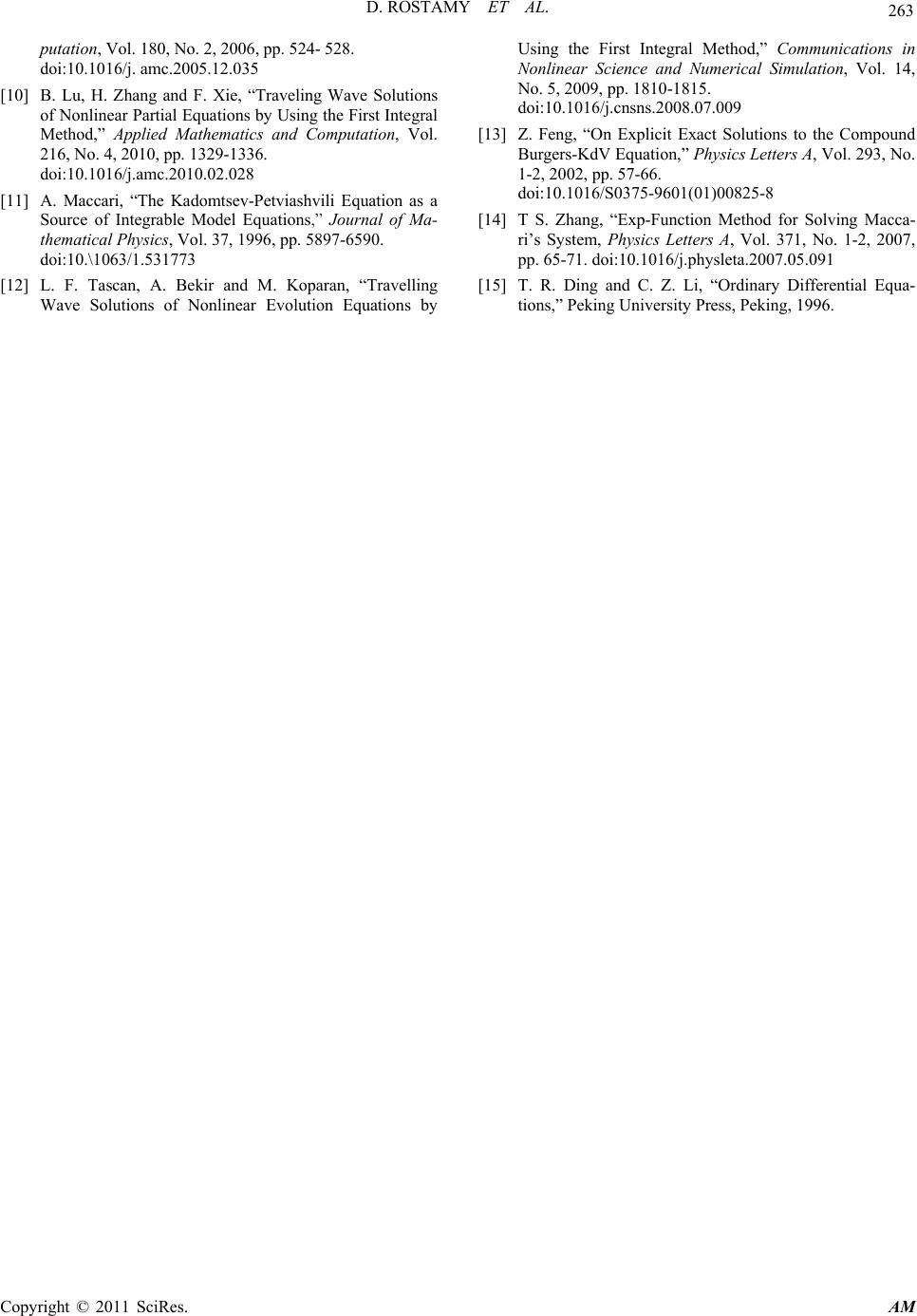 D. ROSTAMY ET AL. Copyright © 2011 SciRes. AM 263 putation, Vol. 180, No. 2, 2006, pp. 524- 528. doi:10.1016/j. amc.2005.12.035 [10] B. Lu, H. Zhang and F. Xie, “Traveling Wave Solutions of Nonlinear Partial Equations by Using the First Integral Method,” Applied Mathematics and Computation, Vol. 216, No. 4, 2010, pp. 1329-1336. doi:10.1016/j.amc.2010.02.028 [11] A. Maccari, “The Kadomtsev-Petviashvili Equation as a Source of Integrable Model Equations,” Journal of Ma- thematical Physics, Vol. 37, 1996, pp. 5897-6590. doi:10.\1063/1.531773 [12] L. F. Tascan, A. Bekir and M. Koparan, “Travelling Wave Solutions of Nonlinear Evolution Equations by Using the First Integral Method,” Communications in Nonlinear Science and Numerical Simulation, Vol. 14, No. 5, 2009, pp. 1810-1815. doi:10.1016/j.cnsns.2008.07.009 [13] Z. Feng, “On Explicit Exact Solutions to the Compound Burgers-KdV Equation, ” Physics Lett ers A, Vol. 293, No. 1-2, 2002, pp. 57-66. doi:10.1016/S0375-9601(01)00825-8 [14] T S. Zhang, “Exp-Function Method for Solving Macca- ri’s System, Physics Letters A, Vol. 371, No. 1-2, 2007, pp. 65-71. doi:10.1016/j.physleta.2007.05.091 [15] T. R. Ding and C. Z. Li, “Ordinary Differential Equa- tions,” Peking University Press, Peking, 1996. |

